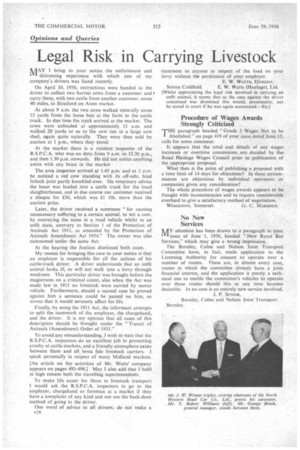Legal Risk in Carrying Livestock
Page 88

If you've noticed an error in this article please click here to report it so we can fix it.
NAAY 1 bring to your notice the unfortunate and I" distressing experience with which one of my company's drivers was faced recently.
On April 10, 1956, instructions were handed to the driver to collect two barren cows from a customer and carry them, with two cattle from another customer, some 40 miles, to Stratford on Avon market.
At about 9 a.m. the two cows walked naturally some 15 yards from the loose box at the farm to the cattle truck. In due time the truck arrived at the market. The cows were unloaded at approximately 11 a.m. and walked 20 yards or so to the cow ties in a large cow shed, again quite naturally. They were then sold by auction at 1 p.m., where they stood.
At the market there is a resident inspector of the R.S.P.C.A. who was on duty frOm 9 a.m. to 12.30 p.m., and then 1.30 p.m. onwards. He did not notice anything amiss with any beast in the market The area inspector arrived at 1.45 p.m. and at 2 p.m. he noticed a red cow standing with its off-side, hind fetlock joint partly knuckled over. On veterinary advice the beast was loaded into a cattle truck for the local slaughterhouse, and in due course our customer received a cheque for £36, which was £1 10s. more than the auction price.
Later, the driver received a summons "for causing unnecessary suffering to a certain animal, to wit a cow, by conveying the same in a road vehicle whilst in an unfit state, contrary to Section 1 of the Protection of Animals Act 1911, as amended by the Protection of Animals Amendment Act 1954." The owner was also summoned under the same Act.
At the hearing the Justices dismissed both cases.
My reason for bringing this case to your notice is that an employer is responsible for all the actions of his cattle-truck driver. A driver understands that an unfit animal looks ill, or will not walk into a. lorry through weakness. This particular driver was brought before the magistrates on a criminal count, also when the Act was made law in 1911 no livestock were carried by motor vehicle. Furthermore, should a second case be proved against him a sentence could be passed on him, so severe that it would seriously affect his life.
Finally, by using the 1911 Act, the informant attempts to split the teamwork of the employer, the chargehand, and the driver. It is my opinion that all cases of this description should be brought under the "Transit of Animals (Amendment) Order of 1931."
To avoid any misunderstanding, I wish to state that the R.S.P.C.A. inspectors do an excellent job in preventing cruelty at cattle markets, and a friendly atmosphere exists between them and all bona fide livestock carriers. speak personally in respect of many Midland markets.
[An article on the activities of Mr. Watts' company appears on pages 493-496.) May I also add that I hold in high esteem both the travelling superintendents.
To make life easier for those in livestock transport 1 would ask the R.S.P.C.A. inspectors to go to the employer, chargehand or foreman at a market if they have a complaint of any kind and not use the back-door method of going to the driver.
One word of advice to all drivers; do not make a r/ statement to anyone in respect of the load on your lorry without the permission of your employer.
E. W. WArrs, Director, Sutton Coldfield. E. W. Watts (Haulage), Ltd.
(Whilst appreciating the legal risk involved in carrying an unfit animal, it seems that as the case against the driver concerned was dismissed this would, presumably, not be stated in court if be was again summoned.--Enj
Procedure of Wages Awards Strongly Criticized
T"paragraph headed "Grade 2 Wages Not to be Abolished" on page 419 of your issue dated June 15, calls for some comment.
It appears that the total and details of any wages increases or overtime concessions are decided by the Road Haulage Wages Council prior to publication of the appropriate proposal.
What then is the point of publishing a proposal with a time limit of 14 days for objections? In these circumstances are objections by individual operators or companies given any consideration?
The whole procedure of wages awards appears to be fraught with inconsistencies and to require considerable overhaul to give a satisfactory method of negotiation.
Wincanton, Somerset. G. C. MARSDEN.
No New Services
NAY attention has been drawn to a paragraph in your .t1 issue of June I, 1956, headed "New Rural Bus Services," which may 'give a wrong impression.
The Burnley, Cottle and Nelson 'Joint Transport Committee have, in fact, made application to the Licensing Authority for consent to operate over a number of routes. These are, in almost every case, routes in which the committee already have a joint financial interest, and the application is purely a technical one to enable the committee's vehicles to operate over these routes should this at any time become desirable. In no case is an entirely new service involved.
J. P. SENIOR, Burnley, Colne and Nelson Joint Transport. Burnley.
















































































































































